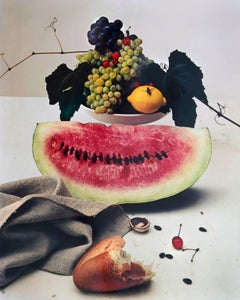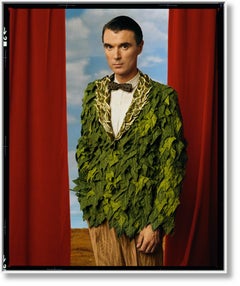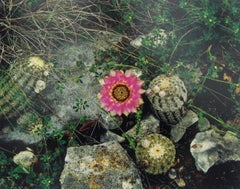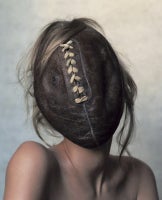Irving Penn Color Photography
With a career in magazines that spanned the mid-20th century heyday of print journalism and lasted through the first decade of the 21st, Irving Penn was the preeminent photographer for six decades at Vogue, where he worked right up until his death, in 2009, at age 92.
Penn’s refined and dynamic photography of models, celebrities and products like Clinique and Jell-O pudding, all shot in compositions of stunning equipoise in the cool remove of his minimal studio setups, were designed to stop traffic and cut through the clutter of magazine pages.
Penn flourished under the mentorship of two legendary art directors: Harper’s Bazaar‘s Alexey Brodovitch and Vogue‘s Alexander Liberman, both Russian émigrés like Penn’s father. Brodovitch introduced Penn to Surrealism and avant-garde photography as his teacher at the Pennsylvania Museum and School of Industrial Art and hired him as his assistant at Harper’s Bazaar during the summers of 1937 and ’38. Penn bought his first camera after graduating that year. He met Liberman in 1941, passing off to the recent New York transplant his freelance art director job at Saks Fifth Avenue. Liberman returned the favor by hiring Penn at Vogue in 1943 to sketch cover concepts, later encouraging him to shoot his unconventional juxtapositions of accessories and household items himself.
Assigned to photograph some portraits in the mid-1940s, Penn took a cue from the stage-set windows at Saks. He angled two studio flats in his studio and placed his subjects, including Truman Capote, Jerome Robbins and Salvador Dalí, in the resulting tight corner, literally and psychologically. Spencer Tracy leans jauntily against the walls in his portrait, while Georgia O'Keeffe simmers straight-armed in her confinement.
Penn didn’t work well with the distractions of the outside world. In 1950, when he was instructed by Liberman to buy an evening jacket and shoot the couture shows in Paris, he managed the assignment by having the dresses brought to him. He rented a top-floor studio with great light but no electricity and photographed models, including Lisa Fonssagrives (whom he married shortly after), against a mottled gray theater curtain that he continued to use for the rest of his career. Between deliveries from Dior and Balenciaga, he began his personal project “Small Trades,” in which he had local Parisians — a knife grinder, a mailman, a cucumber seller — pose for him with tools of their trade against the same backdrop. (He extended the series in London and New York.)
While Penn made bold, reductive still lifes for advertising campaigns throughout his career, in 1972 he applied his sculptural understanding of form to the unlikeliest of subjects: cigarette butts he gathered from the streets. The Museum of Modern Art showed Penn’s cigarette butts in 1975, and the Metropolitan Museum of Art exhibited another series of material salvaged from the street in 1977. At this time, Penn also began revisiting his earlier photographs, reprinting them at larger scale and with the more painterly quality achieved with the platinum-palladium process. In his lush, oversized platinum-palladium prints, he elevates the lowly castoffs to heroic objects worthy of archaeological scrutiny.
Find vintage Irving Penn photography on 1stDibs.
1940s Modern Irving Penn Color Photography
Dye Transfer
1940s Modern Irving Penn Color Photography
Dye Transfer
Late 20th Century Irving Penn Color Photography
Silver Gelatin
1960s Irving Penn Color Photography
Dye Transfer
21st Century and Contemporary Irving Penn Color Photography
Dye Transfer
20th Century Post-Modern Irving Penn Color Photography
Dye Transfer
Early 2000s Contemporary Irving Penn Color Photography
Photographic Paper, C Print, Color, Silver Gelatin
2010s Naturalistic Irving Penn Color Photography
Color, Dye Transfer
2010s Naturalistic Irving Penn Color Photography
Color, Dye Transfer
1980s Photorealist Irving Penn Color Photography
Photographic Paper, C Print, Dye Transfer
Early 2000s Pop Art Irving Penn Color Photography
Photographic Paper, C Print, Color, Silver Gelatin
2010s Naturalistic Irving Penn Color Photography
Color, Dye Transfer
2010s Naturalistic Irving Penn Color Photography
Color, Dye Transfer
2010s Naturalistic Irving Penn Color Photography
Color, Dye Transfer
2010s Naturalistic Irving Penn Color Photography
Color, Dye Transfer
1980s Photorealist Irving Penn Color Photography
Photographic Paper, C Print, Dye Transfer
21st Century and Contemporary Irving Penn Color Photography
Irving Penn color photography for sale on 1stDibs.
Artists Similar to Irving Penn
- 1stDibs ExpertApril 5, 2022Celebrated American fashion photographer Irving Penn made great contributions to photography through his use of simple backgrounds. This gave him greater control over aspects like the lighting, and asserted his subjects and their fashions as the sole focus of the composition. Shop a collection of Irving Penn photography from some of the world’s top sellers on 1stDibs.






